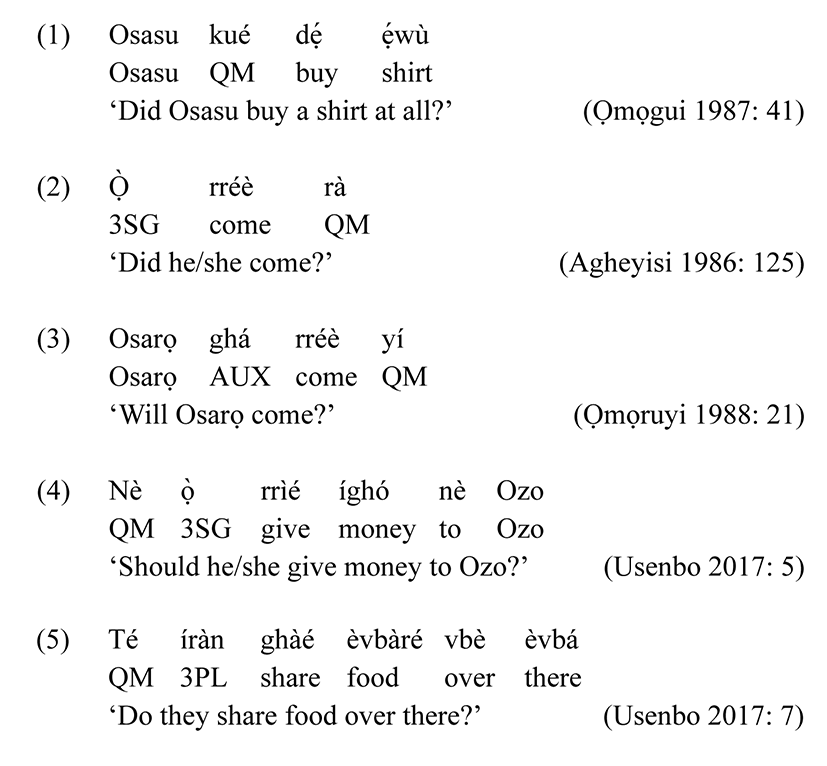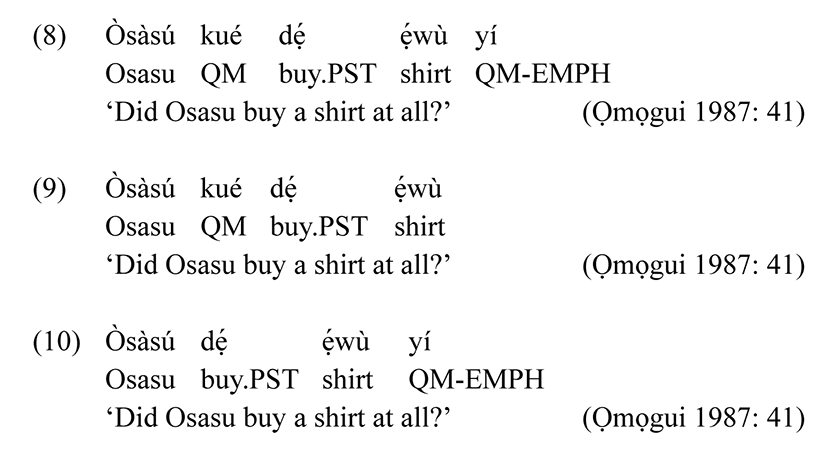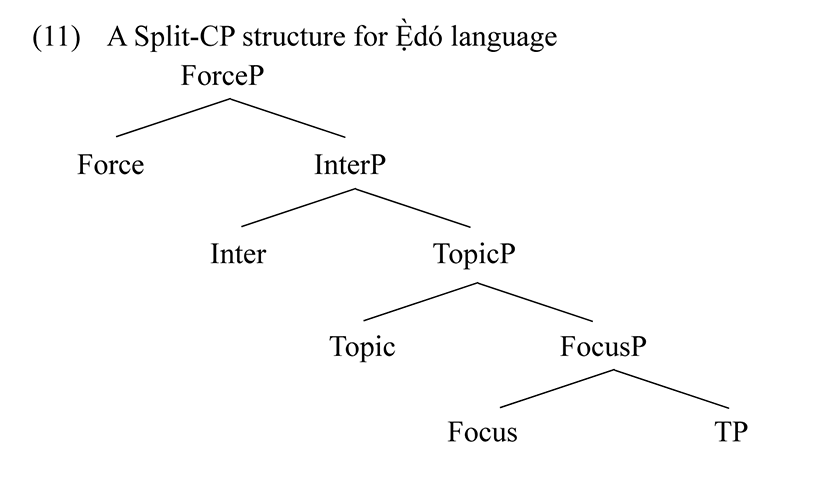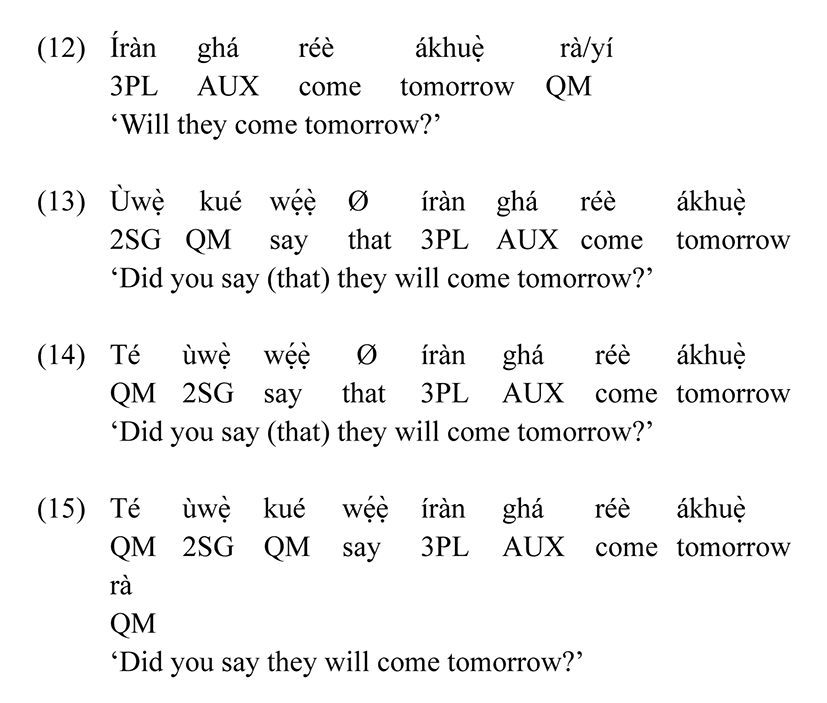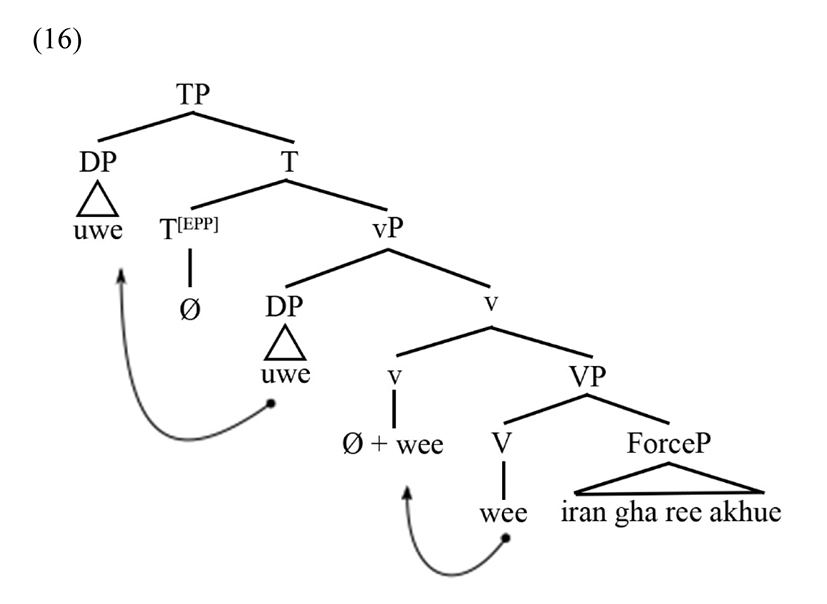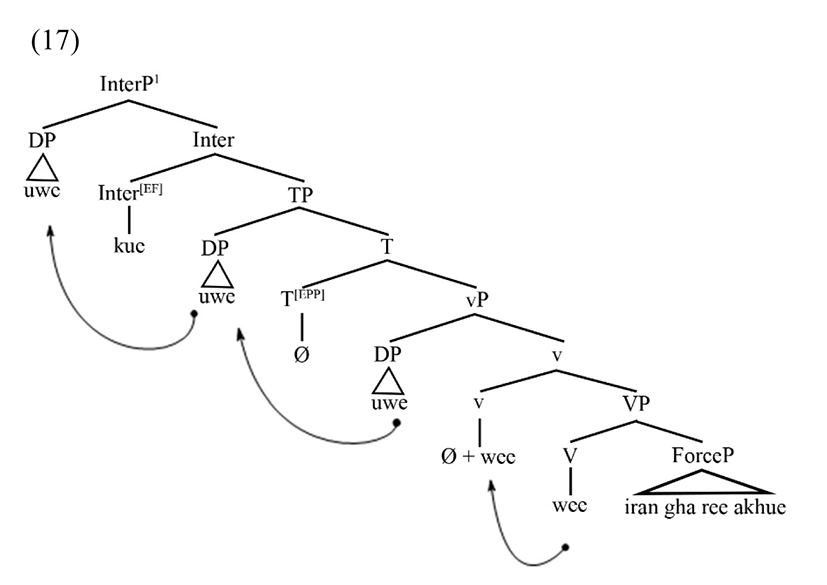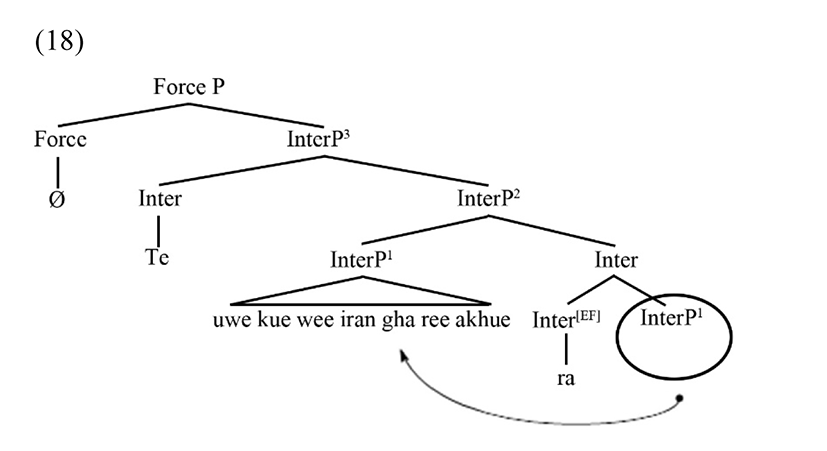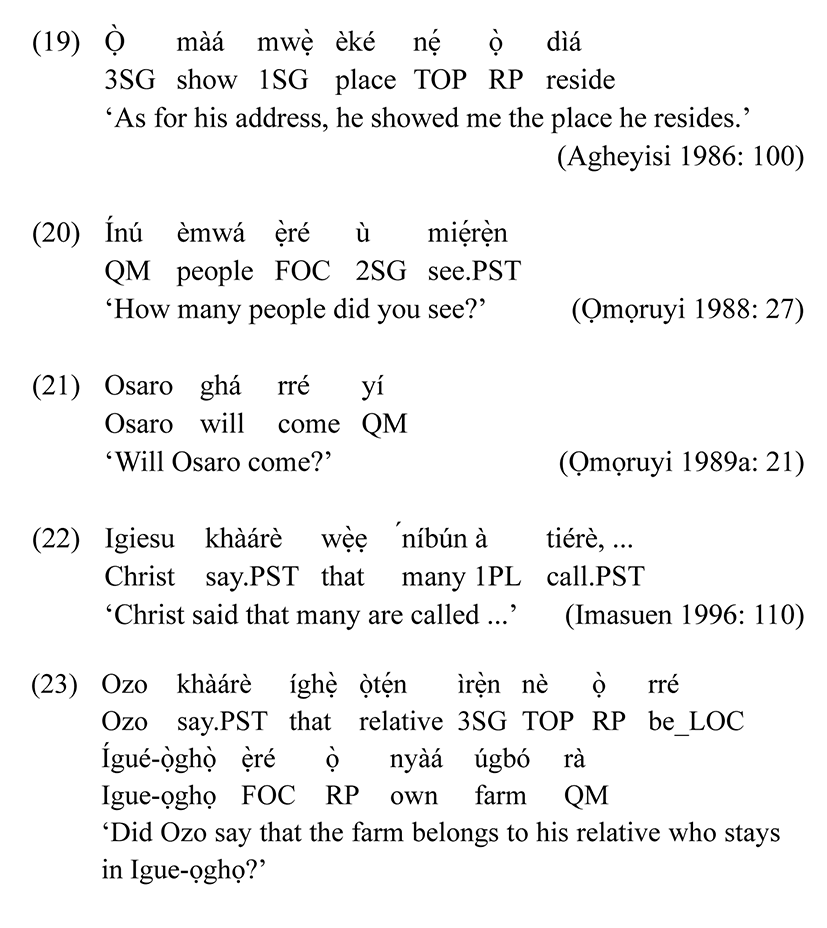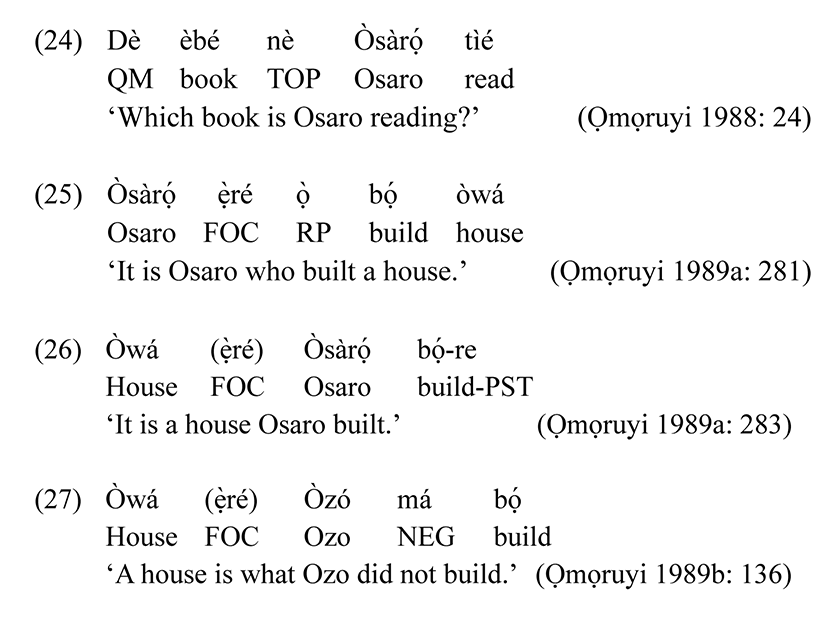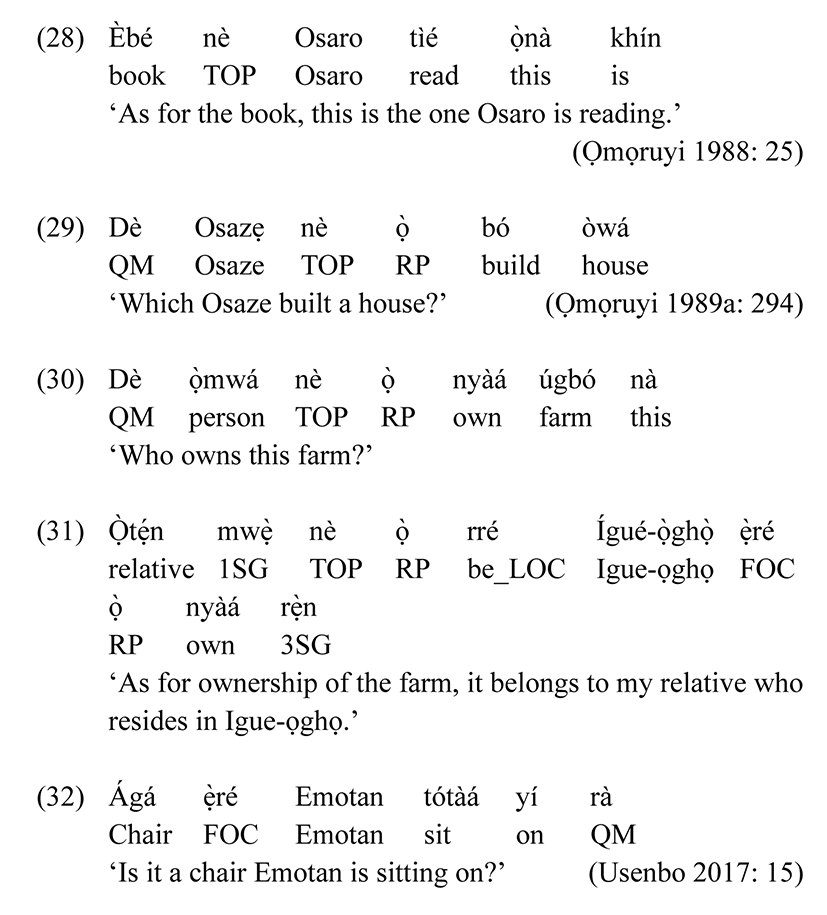1. Introduction
Questions have been featured in discussions of language form and function since the era of classical grammarians, who defined it as “a group of words or sometimes a single word which makes a statement, a command, a question or an exclamation” (Awoyale 1992: 101). At first glance, it seems like one can subsume questions under syntax given that they are types of sentences, and syntax is the linguistic sub-field that studies how to string words into sentences. This initial perception does not take cognisance of the roles phonetics/phonology and semantics play in the grammar of some languages. In Ẹ̀dó for instance, Ọmọgui (1987), Ọmọruyi (1988) and Ọmọruyi (1989a) examine polar question formation in the language and conclude that this type of interrogative can be formed with/without the use of overt markers. Usenbo (2017) investigates the use of overt markers and submits that the language has five of such. That study focuses on the morphology and semantics of the markers.
However, the syntax of polar question formation in the language remains largely unexplored. Although Ọmọgui (1987), Ọmọruyi (1988) and Ọmọruyi (1989a) discuss the syntax of interrogative constructions, their analyses touched on only three polar question markers. These markers first merge within the predicate, but those identified in Usenbo (2017) merge outside the VP1. The issue here is how to relate the syntax of the peripheral markers to that of the predicate internal ones. This gap in knowledge is the reason for the present study. Its aim is to describe the syntax of yes/no questions in the language. The study addresses two research questions. First, what is the structure of yes/no questions in Ẹ̀dó? Second, how is this structure derived?
Responses to both questions are significant because they reveal the syntactic representation of discourse in Ẹ̀dó language. The paper is also relevant to the issue of category proliferation in syntax. This study supports the postulation of distinct functional projections in the left periphery. The paper is in three sections. Section 1, the introduction, provides information about the language, previous studies and the research method. Section 2 discusses the syntax of polar questions. Section 3 contains a summary of the paper.
Ẹ̀dó is an Edoid language (Elugbe 1989) classified under the Kwa branch of the New Benue Congo (NBC) family (Williamson & Blench 2000). The Ethnologue identification number for the language is 639-3, and it is indigenous to seven of the eighteen local government areas of Edo state, South-South Nigeria. Based on the 2010 National Population Commission Report, the estimated land area occupied by this linguistic group is 10,835.37 square kilometres, while the population of first language users is 1,686,041.
Earlier studies submit that there are three markers for yes/no questions in the language; These question markers are kué, rà and yí (Ọmọgui 1987; Ọmọruyi 1988, 1989a). In a more recent study, Usenbo (2017) re-examines polar question markers in the language and argues that Ẹ̀dó has five, not three, of such markers. The additional markers identified in that study are té and nè. The following examples illustrate all five markers.
The examples show that all five markers function in the same manner; They derive questions which require yes/no responses. One would observe the markers occupy different structural positions. Té and nè are clause-initial; kué precedes the lexical verb, while yí and rà are clause-final. The examples above show the use of one marker per sentence. It is possible for two or more markers to co-occur, as in the following example.
In example (6), there is a question marker in each of the possible structural positions. One wonders why this kind of structure exists, given that all three markers perform the same function. Although the markers are used to derive interrogative constructions, the burden of question formation is not even amongst them. For example, Ọmọruyi (1988) points out a distinction in the use of sentence-final markers. As shown in example (7), rà marks alternative polar questions, but yí cannot occur in such structures.
Another reason the language allows the co-occurrence of question markers is the interpretational properties of the question markers. For instance, Ọmọigui (1987) differentiates the question markers based on their contribution to meaning. The thesis submits kué can co-occur with the clause-final marker yí; “when yí is in the same interrogative construction as kué, it makes the question emphatic. In such questions, yí reinforces kué in marking interrogation; when kué is not in the construction, yí functions both as question and emphasis marker” (Ọmọigui 1987: 42).
Besides interpretational differences, Ọmọruyi (1989a) notes a difference between the responses one can elicit using sentence-final question markers. “Respondents only agree or disagree with the assertion in questions formed with yí, but with rà, the respondent can also make an alternative assertion” (Ọmọruyi 1989a: 292).
The study relies on data collected from primary and secondary sources. The secondary data comes from illustrations provided in journal articles (Ọmọruyi 1988, 1989a; Usenbo 2017), unpublished thesis (Ọmọgui 1987), and textbooks (Agheyisi 1986, Imasuen 1996). For primary data, the study conducted a field survey using an open-ended questionnaire, which was administered to fifteen respondents, comprising nine males and six females. Their ages range between 21 and 70 years. Besides the questionnaire, this study also got data from observation of the language in use.
The data were transcribed and coded in the current orthography of the language, but this study has added tone marks to make the data more accessible. Glossing follows the format outlined in the Leipzig Glossing Rules. The study presents the data as textual examples and tree diagrams. For data analyses, the study employs both the MP and the cartographic approach to syntax. In the next sub-section, the paper explains its theoretical orientation. The discussion centres on concepts relevant to the analyses presented here.
The MP assumes there are two levels of linguistic representation: PF and LF. PF handles pronunciation and LF deals with meaning. These levels of representation “interact with two systems of the language faculty: the Sensory-Motor Interface and the Conceptual-Intentional Interface” (Chomsky 2005: 10). Another hypothesis of MP is that the language faculty comprises a lexicon and a computational system. The lexicon specifies items which enter the computational system; “computation arranges these items in a pair (π, λ), where π is a PF object and λ an LF object. The pair is subject to the principle of Full Interpretation, which requires that all features of the pair are legible at the relevant interfaces. If they are legible, the derivation converges at PF and LF, respectively. If either π or λ is illegible, the derivation crashes at the relevant level” (Hornstein et al. 2005: 15). Acceptable structures must converge at both LF and PF.
MP builds structures bottom-up using the operation merge. This operation has two forms: internal merge and external merge. External merge combines a pair of constituents together to form a larger constituent. Sometimes, derivation copies constituents from inside a structure already built to other positions on the tree; this is an internal merge. There is also the operation Agree which is used for feature checking/valuation. Zeijlstra (2012) defines Agree as follows;
Agree is a relation between two constituents: a Probe (α) and a Goal (β). A probe lacking value for a feature searches for a constituent with valued matching features and undergoes agreement with it. For minimal computation, the probe searches the smallest domain (i.e., the c-command domain) to find the goal. Agree is subject to intervention effects, as the operation applies to the first potential (i.e., closest) goal.
Another idea of MP, which this study employs, is the concept of phases. Phases are points in the derivation where structures transfer to articulatory-perceptual (speech) and conceptual-intentional (thought/ meaning) systems. In structural representations, phases are the CP, and the vP with an external argument. Once a structure transfers to the interfaces, it becomes unavailable for subsequent stages of the derivation. This idea is in the following condition.
Phase Impenetrability Condition (Chomsky 2000: 108)
In phase α with head H, the domain of H is not accessible to operations outside α, only H and its edge are accessible to such operations.
The phase impenetrability condition curtails the cycle of grammatical operations; Once operations which apply within a phase are complete, the complement of the phase head (i.e., the domain of H) becomes unavailable for further syntactic operations. Only the head (i.e., H), its specifier (s) and adjunct (s) remain visible in the syntax. There is more to the workings of MP; This sub-section harps on the ones relevant to this paper. The interested reader can learn more from the references cited. For its application to problems other than yes/no questions, see Eleshin (2021) and Punske (2019).
Besides minimalist operations, the analyses take a cue from cartography (Cinque & Rizzi 2008). This approach provides precise yet detailed mapping of syntactic configuration. Specifically, this paper adopts the view of a Split-CP, where question markers project their own phrases.
2. The Syntax of Ẹ̀dó Yes/No Questions
The maximal projection of a sentence is a CP. The head of this phrase performs several functions. For example, it indicates the function of the sentence in a given context—a command or a question. When constituents are preposed for focusing or topicalization they end in the CP. The markers for these constructions differ, so there must be different types of heads in CP. Hence, the idea of a Split-CP. The Split-CP comprises several functional categories which occur above the basic constituents of a sentence (i.e., the left periphery of the clause). For Ẹ̀dó language, this study proposes a simplified schema adapted from Rizzi & Cinque (2016: 146).
The ForceP expresses the illocutionary force, or clause-type information. The head of the InterP is question markers. Topic and focus phrases are for topics and focussed constituents, while TP is for finiteness. In Ẹ̀dó, the head of this phrase might be an auxiliary, an affix, or a tone (Yuka & Omoregbe 2010).
The syntax provides a hierarchical structure where Ẹ̀dó yes/no questions markers head the InterP of a Split-CP. In constructions where there are two or more question markers, InterP would have multiple projections. Consider the following examples.
In the examples above, there are three interrogative sentences which have the same interpretation but different markers. Those structures are not the same; they only appear so, because of the gloss. Each of the interrogative sentences differs in terms of the scope and number of question markers. In Example (12), the clause-final markers question the clause “they will come tomorrow”; whereas in (13), the constituent under interrogation is the person who made the utterance. In Example (14), there is another marker used for questioning clauses, and in (15) we have an example of a structure with three question markers. Consider the derivation of the last example; the paper illustrates it below as (16), (17) and (18).
The embedded ForceP merges with the lexical verb of the matrix clause to form the VP complement of the light verb. Though it lacks morphological content, Chomsky (2008: 21) considers the light verb an affix, which gets its form by attracting a verbal element with semantic content. This explains the V-v movement in the structure above. Following the phase impenetrability condition, the domain of v would transfer to the interfaces, excluding the embedded ForceP from further syntactic operations. This is undesirable, given that the question markers require this phrase to check their features. For this reason, the study adopted the revised form of the condition.
Revised Phase Impenetrability Condition (Chomsky 2004: 108)
At the phase ZP containing phase HP, the domain of H is inaccessible to operations at ZP, only H and the edge of HP are accessible.
The difference between the revised phase impenetrability condition and the original formulation is that the domain of a lower phase head remains visible in the syntax when a higher phase head enters the derivation. Following the revised Phase Impenetrability Condition (PIC), derivation continues with merge of the matrix subject ùwẹ̀ in the specifier of the vP. The vP then merges with a null tense head. To satisfy [EPP] on T, the subject moves from spec-v to spec-T, as shown by the arrows in (16).
Derivation of the polar question continues with merge of TP and kué. This marker checks and deletes its [interrogative] feature with a phrase. The marker also has the feature [EF], which triggers movement to the specifier of an attracting head. The closest constituent which can satisfy both features is the DP in spec-T. This explains its movement to spec-InterP1 in the tree diagram below.
Having completed the lowest InterP, the higher interrogative head-clause-final rà in this example enters the derivation and merges with its complement. This marker checks its [interrogative] feature against a phase in its c-command domain. The clause-final question markers also have the edge feature. So the questioned proposition undergoes internal merge at spec-InterP2, as shown in (18) below.
The derivation continues with merge of the highest question marker, té in this example, and InterP2. Like the clause-final markers, the heads of InterP3 (i.e., clause-initial té, and nè) check [interrogative] against a proposition. However, té and nè do not require internal merge in their specifiers, as there is no difference between the hierarchical order of constituents shown in (18) and the linearized strings which have interrogative interpretations.
From the structure and derivation of (15), it is clear there are differences in the syntax of Ẹ̀dó polar question markers. They all merge externally in the left periphery, but the derivation shows displacement upturns structural adjacency between three of the markers (i.e., kué, yí and rà) and constituents in their respective domains. The MP explains this in terms of the edge feature (Chomsky 2008: 11) or occurrence feature (Chomsky 2005: 18). Movement to satisfy this feature feeds the operation which checks and deletes the interrogative feature of those three question markers. For kué, cyclic movement of the edge of vP suffices for both features, but for yí and rà, moving the head of InterP1 or its edge is insufficient. What makes a convergent derivation for these two markers is the movement of the phase head and pied-piping of all other constituents. The other two markers (i.e., té and nè) check [interrogative] without movement of the questioned proposition.
This analysis is similar to findings about other Kwa languages. For instance, Caesar (2019: 82) shows Dangme polar questions employ sentence-initial and sentence-final markers. Aboh (2010) notes that these markers can trigger movement operations, which reflect the displacement feature of language. Similarly, in their study of Fongbe and Gungbe, Aboh & Pfau (2011: 95) note that “Inter is the locus of [interrogative]. This feature determines the syntax of polar and content-word questions, because it has scope over the proposition which it attracts to its specifier sometimes.” Where such propositions cannot be extracted, pied-piping moves the entire complement up to the specifier of the attracting head.
The previous sub-section addressed the questions of structure and derivation; The analysis raises questions of its own, the most pertinent being applicability. In other words, does Ẹ̀dó language have a split complementiser system? In the following sub-sections, this paper proves its analysis is on the right track adducing evidence from the lexicon, similarities between movement operations in polar question formation and other syntactic processes, and the accumulative realisation of functional heads.
Ẹ̀dó language has separate lexical items for Force, Inter, Topic and Focus. This paper includes at least one example of each type of complementiser. The reader should, however, note that some have several forms. Imasuen (1993) discusses C-type particles which mark declarative and imperative force, while Ọmọruyi (1988) and Ọmọruyi (1989a) identify several other types of question markers. Consider the following sentences.
In (19), there is nè—a complementiser which marks given information. In the Split-CP, we find such information in the Topic Phrase. Rizzi (1997: 285) defines the topic as “a preposed constituent set off from the rest of the clause by comma intonation and normally expressing given information which is available and salient in previous discourse.” As illustrated above, the form nè sets off the topic from the rest of the clause. Example (20) shows ẹ̀ré—a complementiser which introduces new information. This kind of information is in the Focus Phrase. Ọmọruyi (1989a: 281) states that focussing in Ẹ̀dó involves leftward movement of a phrase to the specifier of this complementiser and an optional use of resumptive pronouns at the external merge position of such phrases. The sentences in (21) and (22) show overt forms for Inter and Force, respectively. Inter projects the InterP in (11). Since it conveys clause-type information, this head should project ForceP. This paper separates Inter from Force for two reasons. The first is to establish the existence of the range of complementisers which make up the C-system of this language. The second reason is for structures such as (23), where the question lies in an embedded clause.
Every language has an order of constituents; subject before the verb and then an object, if that verb is transitive. The order may be reversed, depending on the language. This arrangement depicts the ideal situation; In natural language, subjects and objects may be placed farther away from verbs. When constituents appear in positions where they normally do not occur, it indicates that there has been some kind of rearrangement. This repositioning of constituents is not an arbitrary choice; It is driven by structural and/or semantic needs (Al-Horais 2013: 96, Chomsky 2008: 18). Although there are many reasons for moving constituents, the process itself is constrained: Heads can only move into head positions and phrases into phrasal positions. There is also the need to keep movements local, which means the constituent proceeds to the closest head or specifier position.
In the following examples, the study shows constructions which involve movement from TP to the left periphery. Movement in such constructions is identical to what obtains in the polar questions which involve movement of the questioned phrases to Spec-Inter. These examples affirm that the study’s adoption of the revised phase impenetrability condition and its proposal for a Split-CP in Ẹ̀dó is well-founded.
Examples (24)–(27) illustrate content-question, focus constructions, and constituent negation. In (24), there is an interrogative which queries the left dislocated noun phrase. The other examples show subject focus in (25) and object focus in (26). Again, in Example (27) we find focusing, but in a negative construction. The internal merge of èbé, Òsàrọ́ and òwá in these examples is identical to the ones in polar questions formed with the markers kué, rà and yí. These markers attract constituents into their specifiers for the same interpretational reasons as topic and focus in the examples above. The only difference is that other constructions may involve resumptive pronouns, but movement in yes/no questions does not need resumptives.
Studies like Rizzi & Cinque (2016) and Aboh (2010) have shown that the heads in a Split-CP can co-occur; The language under study is no different. Ọmọruyi (1988) and Ọmọruyi (1989a) assert that topic and focus phrases are essential to the derivation of interrogative constructions in this language. Although they are not obligatory in polar question formation, their use in other types of questions strengthens this paper’s proposal for an Ẹ̀dó Split-CP.
Example (28) is the response to the question in (24). Observe that the question and answer involve the movement of a phrase to the left periphery. In the other examples, one finds Inter with Topic and Focus, respectively. Inter in (29) does not require the movement of any constituents. In the previous subsection, we found the same thing in polar questions derived from the markers té and né. Examples (30) and (31) provide another question-and-answer pair. As noted in the literature, there is a similarity between the structure of the question and its response. Example (32) shows a sentence with Focus and Inter. All constituents occur to the left of the question marker. These examples suggest the Split-CP is a reality in this language, and the hierarchy of projections illustrated in (11) is accurate. Where they co-occur, Topic precedes Focus as we have it in the penultimate example. Structures which suggest Topic and Focus are higher than Inter result from internal merge operations, which satisfy features of particular question markers.
3. Conclusion
The aim of this paper is to explain the syntax of yes/no questions in the Ẹ̀dó language. The paper addresses two objectives. One is to determine the structure of polar questions in the language. The other is to show how the structure is derived. Previous studies show there are five polar question markers in the language. The description in those studies suggests the markers have different syntax. We find two of them only in the clause-initial position. One always precedes a verb; and we can only find the last two at the end of a clause.
Despite these observations, this paper submits that all polar questions in the language have the same structure. It proposes a split complementiser system for the language and suggests question markers project a functional phrase in the proposed system. The proposal stems from lexical evidence of distinct functional heads in the Split-CP system, the simultaneous realisation of these heads, and similarities between movement operations in polar questions and other syntactic processes in Ẹ̀dó. Having determined its structure, the paper explicates derivation using the concept of phases from the MP. The analyses show the phase impenetrability condition is too restrictive, but the revised form of the condition proves useful for checking and deleting features of the question markers.

